Food and Drink: Special Occasion Foods
National and Public Holidays
Chinese New Year (Spring Festival)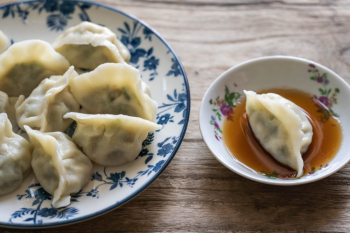
The Spring Festival, or Chinese New Year, is the most significant celebration in China. It marks the start of the lunar new year on the traditional lunisolar Chinese calendar, and is centered around family reunions, prosperity, and luck. Foods symbolizing good fortune and happiness are key to celebrations. The iconic dish is jiaozi (dumplings), symbolizing wealth due to their resemblance to ancient Chinese silver ingots. Fish is a symbol of prosperity because the word for fish, yú, also means “surplus.” Nian gao (sweet rice cakes) represent progress, while mandarin oranges are served for their association with prosperity.
On New Year’s Eve, families come together for a large meal, called Nian Ye Fan (Reunion Dinner). Hot pot, a large communal pot of hot broth served with raw side dishes that are cooked at the table, is symbolic of the reunion of family members. Other common foods eaten at the Chinese New Year include leeks, noodles, and chicken.
Mid-Autumn Festival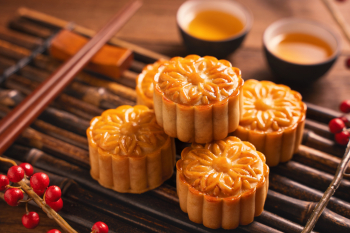
The Mid-Autumn Festival, celebrated on the 15th day of the eighth lunar month, is a time for family reunions and gratitude for the harvest. The focus of the celebration is the moon, symbolizing unity and completeness. The iconic food is the mooncake, a round pastry filled with ingredients such as lotus seed paste, red bean paste, or salted egg yolk.
Other traditional foods enjoyed during the festival include snails and the seasonal seafood, hairy crab, along with pumpkins, duck, and taro. These last two items are combined in the dish of braised duck with taro, with sour plum duck and roasted braised duck other popular duck preparations. Fruits that symbolize fertility and reunion are favored for Mid-Autumn Festival and include pomelos, watermelon, pomegranates, and pears.
Religious and Spiritual Occasions
Hungry Ghost Festival
The Hungry Ghost Festival, observed in the seventh lunar month, is a time to honor and appease the spirits of deceased ancestors. Also called the Zhongyuan Festival in Taoism and the Yulanpen Festival in Buddhism, this is a time when it is believed that spirits roam the earth. Offerings of food are left out for these spirits, and families also prepare feasts to honor their ancestors. Foods such as uncooked rice, peanuts, raw noodles, tea cakes, unpeeled fruit, and uncut meats are commonly placed on altars as offerings. Paper money and symbolic items may also be burned as part of the ritual. The food prepared for this occasion is both symbolic and practical, intended to nourish the spirits and express family loyalty.
Life Milestones and Personal Celebrations
Weddings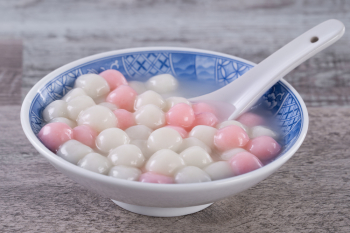
Traditional Chinese weddings are rich with symbolism, including the foods enjoyed at this occasion. The wedding banquet, known as xi jiu—meaning “joyful wine”—features multiple courses that represent blessings for the couple’s future. Whole fish is served for abundance, while lotus seeds and dates symbolize fertility. Sweet, glutinous rice flour balls called tangyuan represent unity and togetherness and are often served as a dessert, sometimes in syrup or broth. These may be small or large, with the bigger size commonly filled with sweetened black sesame, peanut, red bean paste, or fruit. Longans, a tropical fruit also called dragon’s eye, along with chestnuts and peanuts, symbolize fertility and the hope that the married couple will quickly have a child.
Birthdays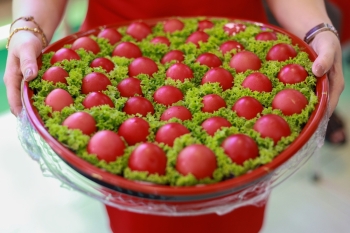
In Chinese culture, milestone birthdays, particularly the 60th and 80th birthdays, are major life events celebrated with family feasts. Chinese often celebrate their birthdays by eating noodle soups, and a significant food is longevity noodles, or chang shou mian. These noodles are served long and uncut, and are never cut with a knife or chopsticks—although they can be bitten. These noodles represent the wish for a long, healthy life. In later years, peaches are often eaten to represent longevity and even immortality.
Red eggs, dyed to symbolize happiness and birth, are often eaten during birthday celebrations and also announce the healthy birth of children. When the child reaches one month of age, the parents throw a party, and guests receive red egg favors. The focus is on ensuring the celebrant's future health and well-being, with dishes that carry good omens.
Cultural and Regional Festivals
Dragon Boat Festival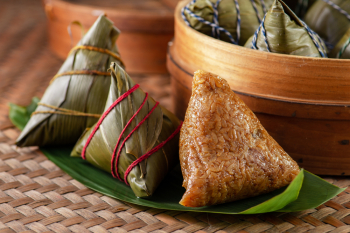
The Dragon Boat Festival is held on the fifth day of the fifth lunar month and may be referred to as the Double Fifth Festival for this reason, as well as Duanwu Jie in Mandarin and Tuen Ng in Cantonese. The festival commemorates the ancient poet, Qu Yuan, who was a counselor to the king of Chu but was exiled after being accused of treason, later drowning himself on the fifth day of the fifth lunar month when he heard Chu had been conquered.
The most iconic food of the festival is zongzi, sticky rice dumplings with various fillings, wrapped in bamboo or reed leaves and in the shape of a pyramid. In northern China, zongzi is typically sweet, filled with red beans or Chinese dates, while in southern China, it is more often savory, featuring ingredients such as salted egg yolk and pork.
Other traditional festival foods are dagao (glutinous rice cakes), jiandui—a fried round cake made of wheat and rice flour and coated in sesame seeds—eel, duck, and hard-boiled eggs steamed with either tea or garlic. Thin pancakes rolled around pork, cabbage, and other vegetables are also typically eaten, and five-color glutinous rice is another popular food, with purple, black, red, yellow, and white symbolizing the golden harvest of the year.
Qingming Festival (Tomb Sweeping Day)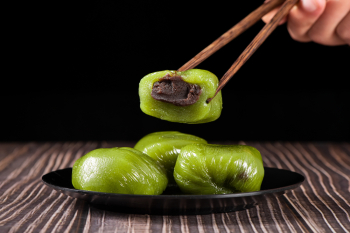
The Qingming Festival is a day to honor deceased ancestors by visiting their graves, sweeping tombs, and offering food and drink as part of ancestral worship. Traditional foods for this occasion include cold foods such as qingtuan—meaning "green dumpling"—made of glutinous rice flour and Chinese mugwort juice, which is why they are green. These are usually filled with sweet red or black bean paste. Sanzi, deep-fried noodles in a twisted pyramid shape, are traditional along with five-colored glutinous rice, snails, peach blossom porridge, eggs, date cake, and zitui buns made from flour, eggs, and dates.
Thin pancakes rolled around pork, cabbage, and other vegetables also are commonly eaten in China's southeastern coastal region. These various foods are offered to the ancestors and also are eaten by the living as part of the festival.
Laba Festival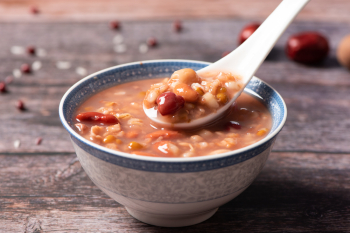
The Laba Festival, observed on the eighth day of the 12th lunar month, is regarded as the prelude to the Chinese New Year (Spring Festival). Historically, it was a time to honor ancestors and pray to deities, heaven, and earth for a good harvest and good luck. Today, the festival focuses on nourishment and gratitude. The central dish is laba porridge, also known as Buddha porridge, and is made of a variety of ingredients, including rice, millet, corn, barley, red dates, lotus seeds, peanuts, and various beans This hearty dish symbolizes abundance and health and is often shared with family, neighbors, and the less fortunate as a way to show compassion and community spirit. Laba vinegar is made by steeping garlic in vinegar and is another traditional practice, with the vinegar eaten with dumplings.
Double Ninth Festival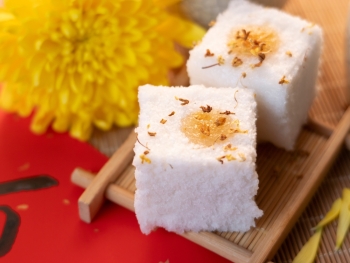
The Double Ninth Festival, held on the ninth day of the ninth lunar month, is a celebration of health and longevity, particularly for the elderly. Many Chinese spend time hiking and appreciating nature. Foods enjoyed for this festival symbolize vitality and strength for the coming year. Traditional foods include chrysanthemum wine and guì huā gāo, or osmanthus cake, a Chinese pastry made with glutinous rice flour, honey, osmanthus—an aromatic flower native to China—and rock sugar. Chongyang cakes are made with rice flour and sugar then baked and steamed before being decorated with jujube fruit (red or Chinese dates), chestnuts, and almonds.
Lantern Festival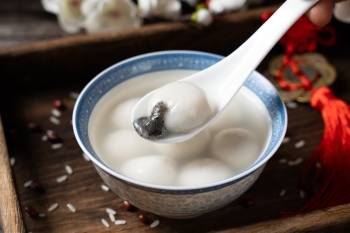
The Lantern Festival marks the end of Chinese New Year celebrations and is held on the 15th day of the first lunar month. It is celebrated by lighting lanterns and eating tangyuan, glutinous rice balls that either have a savory filling, such as pork or vegetables, or sweet fillings including black sesame or sugar. Also known as yuanxiao, tangyuan's round shape symbolizes reunion and harmony, and families eat them together to mark the end of the festive period. Jujube cake, made with sweet rice and jujube (red or Chinese dates) is enjoyed, as are jiaozi—savory dumplings.
Copyright © 1993—2025 World Trade Press. All rights reserved.

 China
China